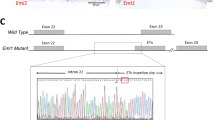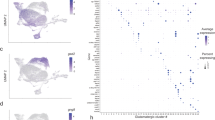Abstract
It has been proposed that growth cones navigating through gradients adapt to baseline concentrations of guidance cues. This adaptation process is poorly understood. Using the collapse assay, we show that adaptation in Xenopus laevis retinal growth cones to the guidance cues Sema3A or netrin-1 involves two processes: a fast, ligand-specific desensitization that occurs within 2 min of exposure and is dependent on endocytosis, and a slower, ligand-specific resensitization, which occurs within 5 min and is dependent upon protein synthesis. These two phases of adaptation allow retinal axons to adjust their range of sensitivity to specific guidance cues.
This is a preview of subscription content, access via your institution
Access options
Subscribe to this journal
Receive 12 print issues and online access
$209.00 per year
only $17.42 per issue
Buy this article
- Purchase on Springer Link
- Instant access to full article PDF
Prices may be subject to local taxes which are calculated during checkout







Similar content being viewed by others
References
Smythies, J. What is the function of receptor and membrane endocytosis at the postsynaptic neuron? Proc. R. Soc. Lond. B 267, 1363–1367 (2000).
Bredt, D.S. & Nicoll, R.A. AMPA receptor trafficking at excitatory synapses. Neuron 40, 361–379 (2003).
Falke, J.J., Bass, R.B., Butler, S.L., Chervitz, S.A. & Danielson, M.A. The two-component signaling pathway of bacterial chemotaxis: a molecular view of signal transduction by receptors, kinases, and adaptation enzymes. Annu. Rev. Cell Dev. Biol. 13, 457–512 (1997).
Samanta, A.K., Oppenheim, J.J. & Matsushima, K. Interleukin 8 (monocyte-derived neutrophil chemotactic factor) dynamically regulates its own receptor expression on human neutrophils. J. Biol. Chem. 265, 183–189 (1990).
Bourke, E. et al. IL-1β scavenging by the type II IL-1 decoy receptor in human neutrophils. J. Immunol. 170, 5999–6005 (2003).
Rosentreter, S.M. et al. Response of retinal ganglion cell axons to striped linear gradients of repellent guidance molecules. J. Neurobiol. 37, 541–562 (1998).
Loschinger, J., Weth, F. & Bonhoeffer, F. Reading of concentration gradients by axonal growth cones. Phil. Trans. R. Soc. Lond. B 355, 971–982 (2000).
Ferguson, S.S. & Caron, M.G. G protein–coupled receptor adaptation mechanisms. Semin. Cell Dev. Biol. 9, 119–127 (1998).
Kapfhammer, J.P. & Raper, J.A. Interactions between growth cones and neurites growing from different neural tissues in culture. J. Neurosci. 7, 1595–1600 (1987).
Kapfhammer, J.P. & Raper, J.A. Collapse of growth cone structure on contact with specific neurites in culture. J. Neurosci. 7, 201–212 (1987).
Shirasaki, R., Katsumata, R. & Murakami, F. Change in chemoattractant responsiveness of developing axons at an intermediate target. Science 279, 105–107 (1998).
Ming, G.L. et al. Adaptation in the chemotactic guidance of nerve growth cones. Nature 417, 411–418 (2002).
Campbell, D.S. et al. Semaphorin 3A elicits stage-dependent collapse, turning, and branching in Xenopus retinal growth cones. J. Neurosci. 21, 8538–8547 (2001).
Campbell, D.S. & Holt, C.E. Chemotropic responses of retinal growth cones mediated by rapid local protein synthesis and degradation. Neuron 32, 1013–1026 (2001).
Jurney, W.M., Gallo, G., Letourneau, P.C. & McLoon, S.C. Rac1-mediated endocytosis during ephrin-A2- and semaphorin 3A-induced growth cone collapse. J. Neurosci. 22, 6019–6028 (2002).
Fournier, A.E. et al. Semaphorin3A enhances endocytosis at sites of receptor-F-actin colocalization during growth cone collapse. J. Cell Biol. 149, 411–422 (2000).
Hertel, C., Coulter, S.J. & Perkins, J.P. A comparison of catecholamine-induced internalization of β-adrenergic receptors and receptor-mediated endocytosis of epidermal growth factor in human astrocytoma cells. Inhibition by phenylarsine oxide. J. Biol. Chem. 260, 12547–12553 (1985).
Di Guglielmo, G.M., Le Roy, C., Goodfellow, A.F. & Wrana, J.L. Distinct endocytic pathways regulate TGF-β receptor signalling and turnover. Nat. Cell Biol. 5, 410–421 (2003).
Schutze, S. et al. Inhibition of receptor internalization by monodansylcadaverine selectively blocks p55 tumor necrosis factor receptor death domain signaling. J. Biol. Chem. 274, 10203–10212 (1999).
Ray, E. & Samanta, A.K. Dansyl cadaverine regulates ligand induced endocytosis of interleukin-8 receptor in human polymorphonuclear neutrophils. FEBS Lett. 378, 235–239 (1996).
He, Z. & Tessier-Lavigne, M. Neuropilin is a receptor for the axonal chemorepellent Semaphorin III. Cell 90, 739–751 (1997).
Kolodkin, A.L. et al. Neuropilin is a semaphorin III receptor. Cell 90, 753–762 (1997).
Winberg, M.L. et al. Plexin A is a neuronal semaphorin receptor that controls axon guidance. Cell 95, 903–916 (1998).
Takahashi, T. et al. Plexin-neuropilin-1 complexes form functional semaphorin-3A receptors. Cell 99, 59–69 (1999).
Tamagnone, L. et al. Plexins are a large family of receptors for transmembrane, secreted, and GPI-anchored semaphorins in vertebrates. Cell 99, 71–80 (1999).
Taylor, B.L. An alternative strategy for adaptation in bacterial behavior. J. Bacteriol. 186, 3671–3673 (2004).
Bibikov, S.I., Miller, A.C., Gosink, K.K. & Parkinson, J.S. Methylation-independent aerotaxis mediated by the Escherichia coli Aer protein. J. Bacteriol. 186, 3730–3737 (2004).
Flanagan, J.G. & Vanderhaeghen, P. The ephrins and Eph receptors in neural development. Annu. Rev. Neurosci. 21, 309–345 (1998).
Hansen, M.J., Dallal, G.E. & Flanagan, J.G. Retinal axon response to ephrin-as shows a graded, concentration-dependent transition from growth promotion to inhibition. Neuron 42, 717–730 (2004).
Yates, P.A., Roskies, A.L., McLaughlin, T. & O'Leary, D.D. Topographic-specific axon branching controlled by ephrin-As is the critical event in retinotectal map development. J. Neurosci. 21, 8548–8563 (2001).
Sakurai, T., Wong, E., Drescher, U., Tanaka, H. & Jay, D.G. Ephrin-A5 restricts topographically specific arborization in the chick retinotectal projection in vivo. Proc. Natl. Acad. Sci. USA 99, 10795–10800 (2002).
Beaumont, V., Hepworth, M.B., Luty, J.S., Kelly, E. & Henderson, G. Somatostatin receptor desensitization in NG108-15 cells. A consequence of receptor sequestration. J. Biol. Chem. 273, 33174–33183 (1998).
Hayes, S., Chawla, A. & Corvera, S. TGFβ receptor internalization into EEA1-enriched early endosomes: role in signaling to Smad2. J. Cell Biol. 158, 1239–1249 (2002).
Vieira, A.V., Lamaze, C. & Schmid, S.L. Control of EGF receptor signaling by clathrin-mediated endocytosis. Science 274, 2086–2089 (1996).
Sorkin, A. & Von Zastrow, M. Signal transduction and endocytosis: close encounters of many kinds. Nat. Rev. Mol. Cell Biol. 3, 600–614 (2002).
Pol, A., Calvo, M. & Enrich, C. Isolated endosomes from quiescent rat liver contain the signal transduction machinery. Differential distribution of activated Raf-1 and Mek in the endocytic compartment. FEBS Lett. 441, 34–38 (1998).
Rizzo, M.A., Shome, K., Watkins, S.C. & Romero, G. The recruitment of Raf-1 to membranes is mediated by direct interaction with phosphatidic acid and is independent of association with Ras. J. Biol. Chem. 275, 23911–23918 (2000).
McDonald, P.H. et al. β-arrestin 2: a receptor-regulated MAPK scaffold for the activation of JNK3. Science 290, 1574–1577 (2000).
Campbell, D.S. & Holt, C.E. Apoptotic pathway and MAPKs differentially regulate chemotropic responses of retinal growth cones. Neuron 37, 939–952 (2003).
Olink-Coux, M. & Hollenbeck, P.J. Localization and active transport of mRNA in axons of sympathetic neurons in culture. J. Neurosci. 16, 1346–1358 (1996).
Bassell, G.J. et al. Sorting of β-actin mRNA and protein to neurites and growth cones in culture. J. Neurosci. 18, 251–265 (1998).
Sotelo-Silveira, J.R. et al. Neurofilament mRNAs are present and translated in the normal and severed sciatic nerve. J. Neurosci. Res. 62, 65–74 (2000).
Litman, P., Barg, J., Rindzoonski, L. & Ginzburg, I. Subcellular localization of tau mRNA in differentiating neuronal cell culture: implications for neuronal polarity. Neuron 10, 627–638 (1993).
Lee, S.K. & Hollenbeck, P.J. Organization and translation of mRNA in sympathetic axons. J. Cell Sci. 116, 4467–4478 (2003).
Fan, J., Mansfield, S.G., Redmond, T., Gordon-Weeks, P.R. & Raper, J.A. The organization of F-actin and microtubules in growth cones exposed to a brain-derived collapsing factor. J. Cell Biol. 121, 867–878 (1993).
Li, C. et al. Correlation between semaphorin3A-induced facilitation of axonal transport and local activation of a translation initiation factor eukaryotic translation initiation factor 4E. J. Neurosci. 24, 6161–6170 (2004).
Cornel, E. & Holt, C. Precocious pathfinding: retinal axons can navigate in an axonless brain. Neuron 9, 1001–1011 (1992).
Shewan, D., Dwivedy, A., Anderson, R. & Holt, C.E. Age-related changes underlie switch in netrin-1 responsiveness as growth cones advance along visual pathway. Nat. Neurosci. 5, 955–962 (2002).
Acknowledgements
We thank D. O'Connor, A. Dwivedy, D. Pask, S. Diamantakis, S. Shipway and E. Miranda for technical assistance, and K. Ohta and M. Tessier-Lavigne for the Sema3A and netrin-1 plasmids respectively. This work was supported by the Wellcome Trust and the Medical Research Council.
Author information
Authors and Affiliations
Corresponding author
Ethics declarations
Competing interests
The authors declare no competing financial interests.
Rights and permissions
About this article
Cite this article
Piper, M., Salih, S., Weinl, C. et al. Endocytosis-dependent desensitization and protein synthesis–dependent resensitization in retinal growth cone adaptation. Nat Neurosci 8, 179–186 (2005). https://doi.org/10.1038/nn1380
Received:
Accepted:
Published:
Issue Date:
DOI: https://doi.org/10.1038/nn1380
This article is cited by
-
The Axonal Actin Filament Cytoskeleton: Structure, Function, and Relevance to Injury and Degeneration
Molecular Neurobiology (2024)
-
Post-endocytic sorting of Plexin-D1 controls signal transduction and development of axonal and vascular circuits
Nature Communications (2017)
-
Single Molecule Translation Imaging Visualizes the Dynamics of Local β-Actin Synthesis in Retinal Axons
Scientific Reports (2017)
-
Multi-phasic bi-directional chemotactic responses of the growth cone
Scientific Reports (2016)
-
Netrin-1 directs dendritic growth and connectivity of vertebrate central neurons in vivo
Neural Development (2015)



